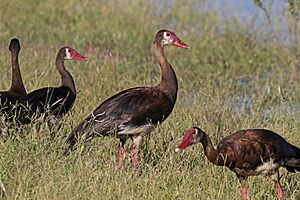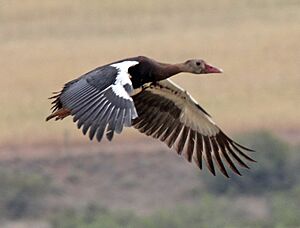Spur-winged goose facts for kids
Quick facts for kids Spur-winged goose |
|
|---|---|
 |
|
| Chobe National Park, Botswana | |
| Conservation status | |
| Scientific classification | |
| Genus: |
Plectropterus
|
| Species: |
gambensis
|
| Subspecies | |
|
P. g. gambensis (Linnaeus, 1766) |
|
 |
|
| Range of G. gambensis Resident | |
| Synonyms | |
|
Anas gambensis Linnaeus, 1766 |
|
The spur-winged goose (scientific name: Plectropterus gambensis) is a very large waterbird found in Sub-Saharan Africa. It belongs to the Anatidae family, which includes geese and shelducks. This goose has special body features that make it unique from other birds in its family. Because of these unique traits, it has its own special group called the Plectropterinae.
Contents
What Does the Spur-Winged Goose Look Like?

Adult spur-winged geese are quite big. They can be about 75–115 cm (30–45 in) (about 2.5 to 3.8 feet) long. Males, called ganders, are much larger than females, called geese. On average, they weigh between 4–6.8 kg (8.8–15.0 lb) (about 9 to 15 pounds). Some males can even weigh up to 10 kg (22 lb) (22 pounds)! Their wings can spread out very wide, from 150 to 200 cm (59 to 79 in) (about 5 to 6.5 feet).
These geese are mostly black. They have a white face and large white patches on their wings. Their long legs are a pinkish-red color. There are two main types, or subspecies, of spur-winged geese. The one found in the north, P. g. gambensis, has a lot of white on its belly. The other type, P. g. niger, found south of the Zambezi River, is smaller and has only a small white patch on its belly. From far away, P. g. niger can look almost completely black.
Males and females look different in a few ways besides size. Males have a larger red patch on their face that extends from their red beak. They also have a small knob, or bump, at the base of their upper beak. These birds are usually quiet. Males sometimes make a soft bubbling sound when they fly or are worried. Both males and females might make other quiet sounds when they are breeding or feel alarmed.
Can Spur-Winged Geese Be Toxic?
It's interesting to know that some spur-winged geese can be toxic, meaning they can be harmful if eaten. This happens if they eat certain blister beetles. These beetles contain a natural poison called cantharidin. When the geese eat these beetles, the poison can stay in their body tissues. If a person were to eat a goose that had this poison, they could get very sick.
Where Do Spur-Winged Geese Live?
Spur-winged geese like to live in open grasslands that have water nearby. This includes lakes, seasonal pools (which dry up sometimes), rivers, swamps, and river deltas. They prefer large inland rivers and lakes and usually avoid salty lakes or high mountain areas. However, they can sometimes be found up to 3,000 m (9,800 ft) (about 9,800 feet) high in eastern Africa. They also don't live in very dry areas.
Life and Habits of the Spur-Winged Goose
Spur-winged geese are social birds. They often gather in small groups, sometimes with up to 50 birds. You can find them around various African rivers, lakes, and swamps. After their breeding season, many geese might gather in one place to molt, which means they shed their old feathers and grow new ones.
These common birds mostly eat plants. They graze on grass, sedges, and aquatic plants. They also eat farm grains, fruit like figs, and root crops. Sometimes, they might eat small fish or insects. They spend the middle of the day resting near water. Outside of the breeding season, they might travel to find new places to feed.
Reproduction and Nesting
The breeding season for spur-winged geese changes depending on where they live. In northern Africa, they usually breed from August to December. In eastern Africa, it's from January to June, and in southern Africa, it's from August to May.
During breeding season, these geese can be very aggressive towards other waterbirds, even other spur-winged geese. They have a sharp spur (a pointy growth) on the bend of their wings, which they might use to fight other birds. Male geese are especially likely to attack other males.
Their nests are usually hidden in plants near water. However, they can be creative with their nest sites! They might use holes in trees, cracks in rocks, old nests built by other birds like hamerkops or African fish eagles, or even the top of a termite mound or an aardvark burrow. If they choose a tree, the nest is usually low to the ground, about 20 to 100 cm (7.9 to 39.4 in) (8 to 40 inches) high, in trees that are 3 to 4 m (9.8 to 13.1 ft) (10 to 13 feet) tall. They generally prefer quiet, peaceful areas along riverbanks and wetlands for their nests.
How Are Spur-Winged Geese Doing?
The spur-winged goose is a common bird in African wetlands. The biggest problems they face are the loss and damage of their wetland homes and hunting that isn't controlled. In 1977, a survey in western African wetlands counted about 10,000 geese, mostly in the Niger basin. This bird is protected by an agreement called the Agreement on the Conservation of African-Eurasian Migratory Waterbirds (AEWA), which helps protect birds that migrate (travel) between Africa and Eurasia.



